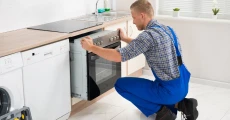Common Fridge Problems & Why They Happen | Troubleshooting Guide

This guide provides a step-by-step approach to fixing an oven light that won’t turn on. From simple bulb replacement to more complex electrical issues, we cover all potential solutions. Follow these steps to diagnose and repair your oven light, ensuring safety and efficiency in your kitchen appliance.
Oven Light Won’t Turn On? 6 Easy Steps to Fix It
Is your oven feeling a bit dim lately? Don’t let a faulty oven light leave you in the dark!
We understand how frustrating it can be when your oven light refuses to cooperate. So, we crafted this guide to help you tackle this common kitchen conundrum. Let’s shed some light on the situation and get your oven gleaming again!
Your fridge is a kitchen superstar as it keeps all your food fresh and drinks cold.
But does the fridge feel warm when you open it?
Is there water all over the floor?
Fridge issues are the worst!
Let’s Get Started!
1. Safety First: Preparing for Repair
Before we go into details, let’s prioritize safety. Your oven is an electrical appliance and you need to make sure you are safe before you experiment anything with it.
- Power Down: Unplug your oven or flip the circuit breaker.
- Cool Your Jets: Let your oven cool completely.
- Gather Your Tools: A screwdriver, gloves, and maybe a flashlight should do the trick.
2. Checking and Replacing the Light Bulb
Now that we’re safe and prepared, let’s start with the most obvious thing.
- Locate the Bulb: It’s usually hiding at the back or side of your oven.
- Remove the Cover: Some twist off, others need a screwdriver.
- Inspect the Bulb: Look for signs of wear and tear.
- Replace if Necessary: Most ovens use a 40-watt appliance bulb (A15). When in doubt, consult your oven’s manual.
Pro Tip: Handle new bulbs with care. Use a tissue or gloves to avoid leaving fingerprints that can cause premature burnout.
3. Inspecting the Light Socket
- Check for Damage: Look for any signs of scorching or loose connections.
- Test for Continuity: Time to break out the multimeter.
4. Examining the Door Switch
Sometimes, the problem isn’t with the light at all – it’s with the switch that tells it when to turn on.
- Locate the Switch: It’s usually near the door frame, playing a crucial role in your oven’s light show.
- Test It Out: Use your multimeter to check for continuity when the door is opened and closed.
5. Assessing the Control Board
- Visible Inspection: Look for any signs of damage or burnt components.
- Professional Help: If you suspect control board issues, it might be time to call in the experts.
6. Resetting the Circuit Breaker
Sometimes, the solution is as simple as flipping a switch – literally.
- Find Your Circuit Panel: It’s probably in that part of your house you rarely visit.
- Locate the Oven’s Breaker: It should be labeled.
- Flip It: Turn it off, wait a moment then flip it back on.
Maintenance Tips for Oven Lights
- Regular Cleaning: Keep that bulb and socket dust-free for optimal performance.
- Use the Right Bulb: Always opt for oven-safe bulbs. Your regular household bulbs might throw in the towel when faced with oven temperatures.







Are You Ready?
Don’t let a stubborn oven light leave you in the dark. With these steps and the expert help of CLT Appliance for Microwave Oven Repair Charlotte NC, you’ll have your oven shining bright in no time.
At CLT Appliance Repair, we’re always ready to come to your rescue. Our expert technicians can diagnose and fix even the most stubborn oven light issues. Just give us a call!
FAQs
Oven light bulbs typically last 900 to 1,000 hours of use. Replace them when they burn out or every 3-4 years, whichever comes first.
No, you need a special oven-safe bulb. Most ovens use a 40-watt appliance bulb (A15) but always check your oven’s manual for the correct type.
This could be due to using the wrong type of bulb, a faulty socket, or power surges. If it persists after replacing the bulb, consider calling a professional.
Yes, as long as you follow safety precautions like unplugging the oven and letting it cool down. If you’re unsure, it’s always best to consult a professional.
This could be due to a loose connection, a faulty door switch, or issues with the control board. If basic troubleshooting doesn’t solve it, professional inspection is recommended.

